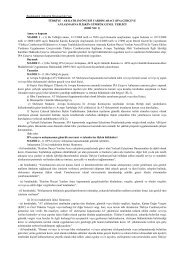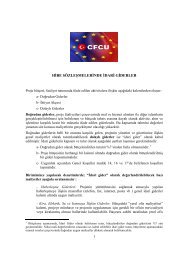Project Cycle Management Training Handbook - CFCU
Project Cycle Management Training Handbook - CFCU
Project Cycle Management Training Handbook - CFCU
Create successful ePaper yourself
Turn your PDF publications into a flip-book with our unique Google optimized e-Paper software.
52<br />
<strong>Project</strong> <strong>Cycle</strong> <strong>Management</strong> <strong>Training</strong> <strong>Handbook</strong><br />
simple questions, and provides a framework for rapidly identifying<br />
information gaps in the Financing Proposal.<br />
Add your own notes here…<br />
Figure 28: The Quality Assessment Tool<br />
PCM Advanced <strong>Training</strong> Quality Assessment Tool<br />
Assessing the Quality of a <strong>Project</strong> Proposal<br />
“<strong>Training</strong> Action for <strong>Project</strong> <strong>Cycle</strong> <strong>Management</strong>”<br />
Module 3: PCM Advanced <strong>Training</strong><br />
<strong>Training</strong> Document<br />
Table of Contents<br />
THE PURPOSE OF QUALITY ASSESSMENT......................................................................................1<br />
QUALITY ASSESSMENT PARAMETERS ........................................................................................... 1<br />
1. Relevance ........................................................................................................................ 2<br />
1.1 Are the beneficiaries clearly identified?..................................................................................2<br />
1.2 Are the problems of the beneficiaries described sufficiently ?..................................................2<br />
1.3 Is the problem analysis sufficiently comprehensive? ...............................................................2<br />
1.4 Do the Overall Objectives explain why the project is important for society? ............................3<br />
1.5 Is the <strong>Project</strong> Purpose defined in terms of benefits to the beneficiaries?...................................3<br />
1.6 Has the need for the results been demonstrated ? ....................................................................4<br />
2. Feasibility........................................................................................................................ 4<br />
2.1 Will the <strong>Project</strong> Purpose contribute to the Overall Objectives (if the assumptions hold)?..........4<br />
2.2 Are the Results described as services to be delivered to the target group? ................................5<br />
2.3 Will the <strong>Project</strong> Purpose be achieved if the Results were delivered? ........................................5<br />
2.4 Are the means sufficiently justified by quantified objectives ...................................................5<br />
2.5 Have important external conditions been identified? ...............................................................6<br />
2.6 Is the probability of realisation of the assumptions acceptable? ...............................................6<br />
2.7 Will implementing agencies be able to implement the project?................................................7<br />
3. Sustainability ................................................................................................................... 7<br />
3.1 Will the relevant authorities have a supportive policy after the project has ended? ..................7<br />
3.2 Is the technology appropriate for the local conditions?............................................................7<br />
3.3 Will the ecological environment be preserved during and after the project? .............................8<br />
3.4 Will there be adequate ownership of the project by the beneficiaries?......................................8<br />
3.5 Will women (and other groups) have adequate access to benefits and production factors during<br />
and after the project? .............................................................................................................9<br />
3.6 Will the implementing agencies be able to provide follow-up after the project? .......................9<br />
3.7 Does the financial and economic analysis confirm that the ‘incremental project’ is efficient,<br />
effective, viable and relevant?.............................................................................................. 10





